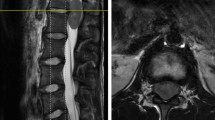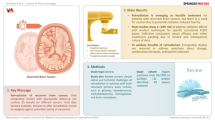Abstract
The purpose of the study is to report long-term outcomes following surgery and radiotherapy for intracranial ependymoma. We retrospectively reviewed the medical records of patients treated with radiotherapy for localized intracranial ependymomas from 1964 to 2006. Patients with subependymomas and ependymoblastomas, and those undergoing re-irradiation, were excluded. Our study population is 44 patients: 37 infratentorial lesions, 7 supratentorial. All patients had postoperative radiotherapy; most received sub-total resection and one-third received gross total resection. Most patients received local radiotherapy alone (median tumor dose 55 Gy); one-quarter received craniospinal irradiation (median dose 35 Gy). The 5- and 10-year local-control rates for all patients were 60 and 46%, respectively; 23% of local recurrences occurred after 5 years. Ninety-five percent of the patients recurred at the primary site; 5% had spinal seeding with no evidence of disease at the primary site. No patient who received craniospinal irradiation recurred in the spine. The 5- and 10-year disease-free survival and overall-survival rates for all patients were 60 and 42% and 57 and 43%, respectively. On multivariate analysis, age ≥18 years, gross total resection and infratentorial site were associated with improved local control. No patient with continuous local control had grade 4 or 5 toxicities; 27% of patients had grade 2 or 3 toxicities. One patient developed a radiation-induced meningioma >20 years after radiotherapy. Maximal safe resection followed by adjuvant radiotherapy provided local control in one-half of patients at 10 years. Age, extent of surgery, and location were identified as major independent prognostic factors in patients with intracranial ependymomas.

Similar content being viewed by others
References
Paulino AC, Wen BC, Buatti JM et al (2002) Intracranial ependymomas: an analysis of prognostic factors and patterns of failure. Am J Clin Oncol 25:117–122
Mansur DB, Perry A, Rajaram V et al (2005) Postoperative radiation therapy for grade II and III intracranial ependymoma. Int J Radiat Oncol Biol Phys 61:387–391
Metellus P, Barrie M, Figarella-Branger D et al (2007) Multicentric French study on adult intracranial ependymomas: prognostic factors analysis and therapeutic considerations from a cohort of 152 patients. Brain 130:1338–1349
Metellus P, Figarella-Branger D, Guyotat J et al (2008) Supratentorial ependymomas: prognostic factors and outcome analysis in a retrospective series of 46 adult patients. Cancer 113:175–185
Oya N, Shibamoto Y, Nagata Y et al (2002) Postoperative radiotherapy for intracranial ependymoma: analysis of prognostic factors and patterns of failure. J Neurooncol 56:87–94
MacDonald SM, Safai S, Trofimov A et al (2008) Proton radiotherapy for childhood ependymoma: initial clinical outcomes and dose comparisons. Int J Radiat Oncol Biol Phys 71:979–986
Shu HK, Sall WF, Maity A et al (2007) Childhood intracranial ependymoma: twenty-year experience from a single institution. Cancer 110:432–441
Jaing TH, Wang HS, Tsay PK et al (2004) Multivariate analysis of clinical prognostic factors in children with intracranial ependymomas. J Neurooncol 68:255–261
Bouffet E, Perilongo G, Canete A et al (1998) Intracranial ependymomas in children: a critical review of prognostic factors and a plea for cooperation. Med Pediatr Oncol 30:319–329
Perilongo G, Massimino M, Sotti G et al (1997) Analyses of prognostic factors in a retrospective review of 92 children with ependymoma: Italian Pediatric Neuro-oncology Group. Med Pediatr Oncol 29:79–85
Pollack IF, Gerszten PC, Martinez AJ et al (1995) Intracranial ependymomas of childhood: long-term outcome and prognostic factors. Neurosurgery 37:655–666
Reni M, Gatta G, Mazza E et al (2007) Ependymoma. Crit Rev Oncol Hematol 63:81–89
Merchant TE, Li C, Xiong X et al (2009) Conformal radiotherapy after surgery for paediatric ependymoma: a prospective study. Lancet Oncol 10:258–266
Vanuytsel LJ, Bessell EM, Ashley SE et al (1992) Intracranial ependymoma: long-term results of a policy of surgery and radiotherapy. Int J Radiat Oncol Biol Phys 23:313–319
Kaplan EL, Meier P (1958) Nonparametric estimation from incomplete observations. J Am Stat Assoc 53:457–481
Cox DR (1972) Regression models and life tables. J R Stat Soc Ser B (Methodological) 34:187–220
Cancer Therapy Evaluation Program (2010) Common terminology criteria for adverse events v4.0, DCTD, NCI, NIH, DHHS. http://ctep.cancer.gov/protocolDevelopment/electronic_applications/docs/ctcae_index.pdf#search=“commonterminology”. Accessed 6 April 2010
Merchant TE, Haida T, Wang MH et al (1997) Anaplastic ependymoma: treatment of pediatric patients with or without craniospinal radiation therapy. J Neurosurg 86:943–949
McGuire CS, Sainani KL, Fisher PG (2009) Both location and age predict survival in ependymoma: a SEER study. Pediatr Blood Cancer 52:65–69
Horn B, Heideman R, Geyer R et al (1999) A multi-institutional retrospective study of intracranial ependymoma in children: identification of risk factors. J Pediatr Hematol Oncol 21:203–211
Sala F, Talacchi A, Mazza C et al (1998) Prognostic factors in childhood intracranial ependymomas: the role of age and tumor location. Pediatr Neurosurg 28:135–142
Foreman NK, Love S, Thorne R (1996) Intracranial ependymomas: analysis of prognostic factors in a population-based series. Pediatr Neurosurg 24:119–125
Kovalic JJ, Flaris N, Grigsby PW et al (1993) Intracranial ependymoma long term outcome, patterns of failure. J Neurooncol 15:125–131
McLaughlin MP, Marcus RB Jr, Buatti JM et al (1998) Ependymoma: results, prognostic factors and treatment recommendations. Int J Radiat Oncol Biol Phys 40:845–850
Robertson PL, Zeltzer PM, Boyett JM et al (1998) Survival and prognostic factors following radiation therapy and chemotherapy for ependymomas in children: a report of the Children’s Cancer Group. J Neurosurg 88:695–703
Merchant TE, Boop FA, Kun LE et al (2008) A retrospective study of surgery and reirradiation for recurrent ependymoma. Int J Radiat Oncol Biol Phys 71:87–97
CERN Foundation (2010) Clinical trials. http://www.cern-foundation.org/Content.aspx?id=492
Acknowledgments
The authors would like to thank Jessica Kirwan, MA, and the research staff at the University of Florida with helping collect patient records and preparing the manuscript.
Author information
Authors and Affiliations
Corresponding author
Rights and permissions
About this article
Cite this article
Swanson, E.L., Amdur, R.J., Morris, C.G. et al. Intracranial ependymomas treated with radiotherapy: long-term results from a single institution. J Neurooncol 102, 451–457 (2011). https://doi.org/10.1007/s11060-010-0344-0
Received:
Accepted:
Published:
Issue Date:
DOI: https://doi.org/10.1007/s11060-010-0344-0




